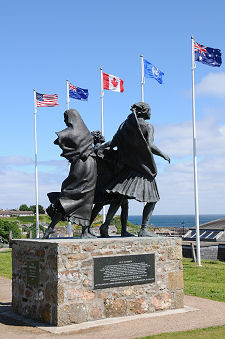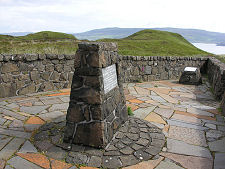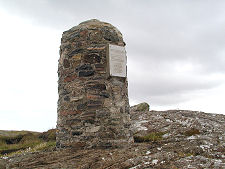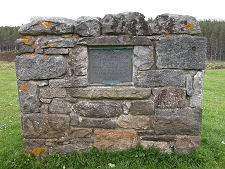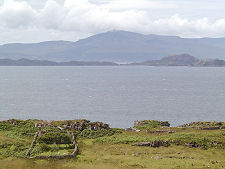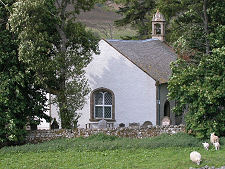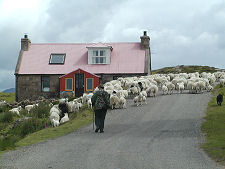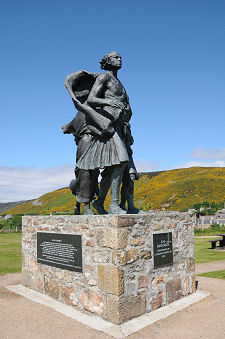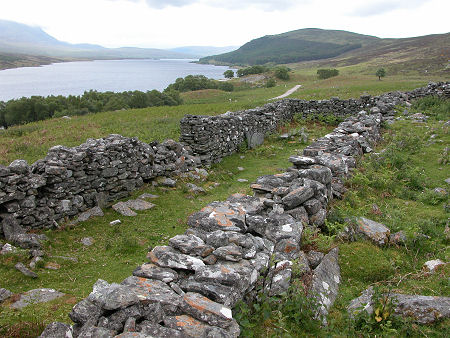 Clearance Village, Strathnaver |
The Highland Clearances form one of the most deeply emotive topics in Scottish history, and one of the most controversial. The term usually describes the process in which, between about 1750 and about 1880, large numbers of Scottish Highlanders and Islanders were displaced from the traditional lands their families had occupied for generations, ending up in marginally viable coastal settlements, as fodder for central Scotland's rapidly growing industries, or as emigrants. It is possible to read many different accounts of the Highland Clearances, and find within them nearly as many conflicting views about what happened, and, especially, why it happened and who was responsible. There are even widely different views of the numbers of people involved.
The Edinburgh-based Government of Scotland had been trying, with mixed success, to gain control over the Highlands and Islands from what it viewed as "wild, wykked Hieland-men" ever since it ended the Norse influence over the area in 1266. Various methods were tried, from a period of attempted control by proxy via the Lords of the Isles, to James V's direct action against clan chiefs and James VI's commissioning of the Fife Adventurers in 1597 to take over the Isle of Lewis and use all necessary means to "root out the barbarous inhabitants". The 1692 Glencoe Massacre by Government troops of an allegedly dissenting clan can be seen in the same light, as can the building of General Wade's network of military roads across the Highlands in the years after the 1715 Jacobite uprising.
But despite all this, clan society still retained its feudal traditions at the start of the 1745 Jacobite uprising. Each clan retained its own lands. Control over the clan lands was exercised by the clan chief, who traditionally leased out the clan lands to a number of tacksmen. You can think of these as the nobles or middle managers of the clan, and they were central to the way the entire clan system functioned.
The tacksmen divided much of the land into small parcels, which they let to tenants and sub-tenants, who might also share some common grazing land. The tenants and sub-tenants would produce what they could from their parcel of land, usually paying rent in the form of goods and services: working their tacksman's lands on demand, or turning out for military service. The tacksmen would in turn be obliged to provide the clan chief with goods, labour when needed, and armed clansmen.
The whole thing worked very like an extended family, hence the common reference to the clan as a family. From the chief's point of view he gained the military muscle he needed to exercise control over his lands in the face of external threats, and the prestige that went with that. From the tacksman's point of view, his obligations to the chief were invariably less than the sum of the obligations of his tenants to him, so he, too did pretty well from the arrangement. And from the point of view of the tenants and sub-tenants, the ordinary clansmen, they achieved a degree of security that would never have otherwise been available to them, both in terms of being part of the collective strength of the clan, and having access to a means of subsistence.
From an economic and agricultural perspective, the clan system made no sense at all. But within the deeply turbulent circumstances of the Highlands and Islands over many centuries, it is easy to see how it developed and why it persisted. In many ways it is best not to think of it as an agricultural system at all: it was primarily a means of providing the clan chief with able, available and motivated clansmen to do his bidding and help him retain (or, ideally, expand) the clan lands.
Although this traditional way of life had equipped Highlanders increasingly poorly to deal with the pressures of the outside world over the century since 1650, it was the final defeat of the Jacobite uprising at the Battle of Culloden on 16 April 1746 that triggered the start of its end. In the aftermath of the battle, clan chiefs who had supported the Jacobite cause had their lands seized by the Crown, and government troops spread out across the Highlands and Islands seeking revenge against anyone who was, or who they believed might be, a Jacobite sympathiser.
But the key to the demise of the clan system was more subtle: and came in the form of the Heritable Jurisdictions Act of 1746. Traditionally, many clan chiefs had exercised the delegated powers of the Crown by dispensing justice within their areas: and many more had acted as if they could, usually without challenge. The seizure of the estates of Jacobite supporters after Culloden had allowed the government to take back many of these delegated powers. The aim of the 1746 Act was to ensure that in future, all areas of Scotland would be subject to the direct jurisdiction of the Crown. Under the act, surviving rights of jurisdiction were purchased back by the government from clan chiefs, some of whom received thousands of pounds in compensation.
The main result was to render pointless the traditional clan system. Clan chiefs were no longer masters of all they surveyed, and it no longer made sense for them to measure their importance in terms of the numbers of armed clansmen they could raise. And they certainly no longer wanted a layer of intermediaries creaming off much of the meagre agricultural value being produced by the tenants and sub-tenants. A large population ceased being the chief's main asset: and "overpopulation" became regarded as a serious problem. To thrive in the changed circumstances the clan chiefs needed to compete on different terms, and that meant generating a monetary income from lands they thought of as their own, even if in the past those lands had only been "theirs" as part of a wider structure that safeguarded the interests of the whole clan. The clan chiefs had become landlords.
The first group to be directly affected by these changes were the tacksmen. Some stayed and tried to generate more income from the land to pay the higher rents being demanded of them. Many more simply left for other parts of Scotland or abroad, sometimes taking all their tenants with them to build new lives together. This first stage of the Clearances, in the 10 years from 1763, resulted in around 10,000 Highlanders emigrating from Scotland, many of them tacksmen, usually the most educated, able and entrepreneurial people in the old society.
Meanwhile, the Highlands and Islands were increasingly becoming a rich hunting ground for what we would now call agricultural consultants: people keen to sell their expertise and advice to new-style landlords only too happy to find out how to increase the income from their lands. Suddenly it was no longer just the tacksmen who had no place in what was left of clan society: now the tenants and sub-tenants were increasingly also being seen as surplus to requirements, as landlords discovered that they could make large amounts of money by grazing sheep. Many fewer people were needed to shepherd sheep than had been needed to work the land before: and the skills were so different that experienced shepherds were often brought in from southern Scotland and England, leaving the indigenous population with no work and no income at all.
The result was the start of a mass migration out of the traditional clan lands. Sometimes this was voluntary (albeit with the sole alternative of starvation) and sometimes it was given more urgency by landlords and their agents, some of whom were quite happy to burn people out of homes their families had lived in for generations if it meant clearing them off the land more quickly. Some of these displaced people contributed to a second wave of emigration from Scotland in the decade either side of 1800. Others left to seek employment in the rapidly expanding industries of central Scotland. And others took advantage of the Government's enthusiasm for the qualities of Highland troops by joining the Army. But many tried to settle in new communities that grew up along the coast, often with the active support of landlords who believe that they might derive an income from these people if they could be coerced into adopting a new lifestyle, combining crofting with fishing: something previously only exploited on any scale by Dutch fishing boats operating in Scottish waters.
From 1781 a new factor entered the economic equation, when the Napoleonic Wars caused the British Government to place high levels of duties on the import of Spanish barilla, a plant used in the production of an alkali important to industry. It was already known that this could be obtained by burning a type of seaweed called kelp, which was found in vast quantities around the coasts of Scotland. But it had always been much cheaper to obtain it from barilla until the new duties tipped the balance in favour of Scottish kelp. As a result the Highlanders who remained in the new coastal settlements became seen as an asset, and landlords who had been urging for government assistance with emigration to ease "overpopulation" started to press for measures to prevent emigration.
At the height of the industry in the early 1800s, it is estimated that up to 50,000 Highlanders were employed collecting and processing kelp, and that the annual income from the industry in western Scotland alone approached £500,000. But after the Napoleonic Wars ended, the tariffs on barilla were reduced, imports increased, and Scotland's kelp industry could no longer compete. Little of the income derived from it had been invested in infrastructure or in other economic activity, and the result was more talk of "overpopulation" and the resumption of large scale emigration.
At the same time, areas of the interior that had not already been cleared to make way for sheep were now being "improved". The most notorious clearances took place on the 1.5 million acre estates of the Countess of Sutherland and her husband, the Marquess of Stafford (later to become the Duke and Duchess of Sutherland), from which 15,000 people were cleared between 1811 and 1821. On one occasion a witness reported seeing 250 crofts on fire from a single vantage point, and in 1816 the Countess's factor, Patrick Sellar, was tried but acquitted on charges of arson and culpable homicide of the elderly Margaret MacKay.
Emigration continued apace into the 1850s, with a further impetus being given when potato blight arrived in Scotland in 1846. The effects of the Highland Potato Famine that followed were made much worse because crofters had become increasingly dependant on the potatoes they could grow in the limited land available in the new coastal settlements. Meanwhile, public awareness of, and opposition to, clearance was beginning to mount. A turning point came with the publication in the Times on 2 June 1845 of an article by a correspondent who described finding 80 people, cleared from their lands in Glen Calvie, sheltering in the churchyard at Croick. Nonetheless clearance continued on a decreasing scale for another 30 years.
The final act took place in 1882 at "The Battle of the Braes". 50 policemen arrived on Skye from Glasgow to help the landlord evict crofters from his land, only to be beaten back by large numbers of men, women and children. The reporters who accompanied the police to Skye reported very sympathetically on the plight of the crofters, and the government responded the following year by appointing "The Royal Commission of Inquiry into the Condition of Crofters and Cottars in the Highlands and Islands", also known as the "Crofters Commission" or the "Napier Commission". The Highland Clearances were, finally, over. They are remembered by monuments in many parts of Scotland, most notably the Emigrants Statue in Helmsdale.
Reasonable estimates suggest that during the first stages of the Highland Clearances, from 1760 to 1800, over 70,000 Highlanders and Islanders emigrated, with perhaps a similar number following in the years from 1800 to 1860. Meanwhile, during the entire period of the Clearances, some 150,000 Highlanders and Islanders were cleared from their ancestral lands. To give a sense of the scale of this relative to the overall population, the total number of people living in 1801 in what are now the council areas of Highland, Western Isles, and Argyll & Bute was 260,000.

